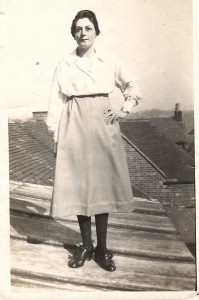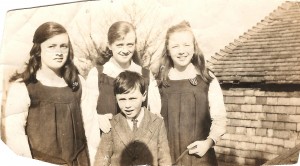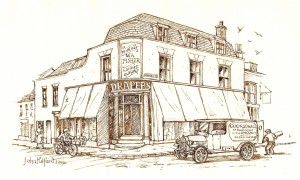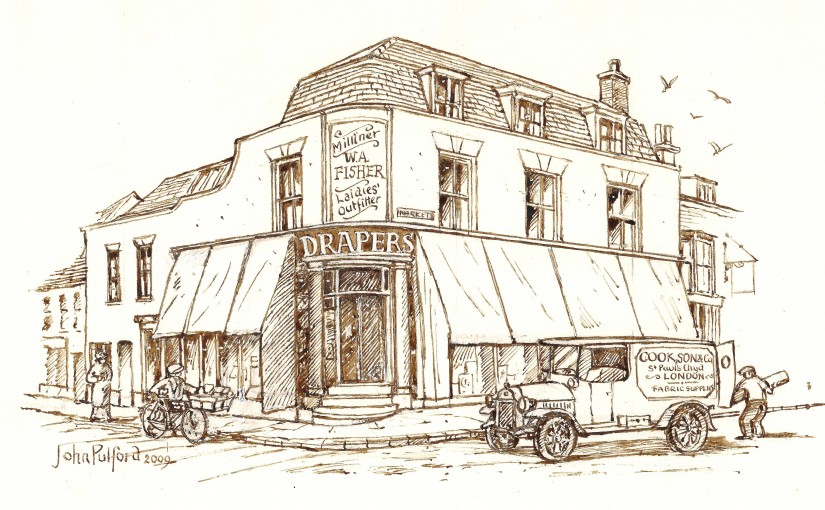Memories of life in a Rye draper’s shop in the early 1920s
By J C Pulford
The stairs that led up to Florence Sparrow’s bedroom above a Rye draper’s shop also led to the roof. Here, ‘off-duty’ hours were often spent reading, sunbathing and watching life in the town below. Never far from her Kodak No 2A Brownie box camera, this young shop assistant captured these moments and the images of her friends and colleagues in the first few years after the First World War.

Florence (my grandmother) was born in Lingfield, Surrey in February 1900, and attended school there from the age of five to fourteen. She did well in her lessons, achieving prizes in some subjects as she did at Sunday school. On the way home from school she used to pass a milliner’s and draper’s shop in the High Street owned by the Postmaster, William Fisher, and run by his wife Henrietta. Florence would stop and talk to their three daughters and later, on leaving school, was offered a position as an apprentice in the shop. After initial opposition from her mother who wanted her to go into service and told her that, as a shop girl, she wouldn’t ‘be good for anything’ when she got married, Florence accepted the job for two shillings (10p) a week. After six months she received an extra sixpence (2.1/2p) for having learnt how to serve customers correctly.

Early in 1919 the Fishers, who came from Woodchurch, Kent, decided to increase the size of their business and moved to Rye with their four children, Gwendoline, fourteen, Eileen twelve, Editha ten and Vernon, their seven-year-old-son. So it was that they acquired the draper’s shop on the corner of Lion Street and Market Street, previously owned by Delves and Son and later by Hide Bros.
Florence also decided to leave home and move with them beginning her new life in the shop she still clearly recalled when her memories were recorded in 1986.
“When I came to Rye with them I was earning 17 shillings a week (87½p ). We used to get staff discount on everything we bought, 2 shillings in the pound, something like that, not much. It all depended what it was you were buying, or what mood they felt in. I shared a room with Miss Mandry and we looked over to Lion Street School. We had a nice little room but we had to go up two flights of stairs and then down a flight. When we went up the stairs we could open the door on to the roof . I had my photo taken lying on the roof with Eileen Fisher. Only Miss Mandry and I lived in; Miss Palmer, Miss Haybourne and Miss Dawes all lived at home. There was also Miss Baker from Peasmarsh.”

The entrance to the shop was on the corner of Market Street and Lion Street and the shop itself was on two levels. The cloth counter and the haberdashery were downstairs and at the back of the shop a flight of stairs led up to the women’s clothing and millinery department. From the shop, about six wooden steps led down into the living-quarters and on the right was a big dining-room looking out on to the patio at the back. This was at the top of the steps which led down to a kitchen, “There were no living quarters downstairs, only the kitchen. When you came out of that kitchen you turned out to where the tap was. There was only the dresser and things in this kitchen; it was all stone floors. The maids must have cooked their dinner there, there was nowhere else to cook it. They looked after Mr & Mrs Fisher who lived upstairs.”
The front door to the living quarters was in Lion Street and, looking from the inside, the front room was to the right with Florence’s bedroom above. Facing the stairs that led from the living quarters into the back of the shop was a little glass office occupied by Miss Clark the cashier.
“Her father was Charlie Clark who kept the Cock Inn, Peasmarsh. I was very friendly with her and the times I cycled with her from Rye to the Cock Inn Florence remembered the long hours she had to work each day. When she started in Lingfield as an apprentice it was from eight o’clock in the morning until eight o’clock at night. At Easter time when they were busy upstairs in a showroom serving people new costumes or new dresses or hats, it was nine before they got home because everything had to be put away when they had finished. “You locked the door but you’d be working upstairs. It closed half-day on Wednesdays in Lingfield; in Rye we closed on Tuesday. I remember when we started closing at six o’clock; an Act came in about shop hours. An Act also came in to say you had to have stools behind the counter to sit on, otherwise you stood there all day and it was very tiring.”
When she first came to Rye, Florence worked with the ‘heavy’ materials, doing all her own ordering from travelling salesmen who in return gave her presents such as towels. Having had experience of hat trimming in Lingfield, Florence moved upstairs but still used to serve costumes and dresses.
“When there was a rush of orders I used to sit with Miss Mandry and make hats from buckram and put straw all round them. People used to come in and if they didn’t see what they wanted, what were called ready-made hats, they used to say ‘No, that’s not quite what I want’, so we used to get out a pile of buckram shapes; some were all round, some were turned up at the back. Some of them had a bow at the back, some at the sides. If they [the customers] chose their shape, we used to ask what colour they would like it – cream straw or blue straw? The straw came in coloured, we used to get all our millinery from Vyse and sons; most of the heavy stuff used to come from Cook and sons, St. Paul’s Churchyard [actually Cook, Son & Co JCP]. You couldn’t make too many in a day. You had to do it properly and you had to stitch round twice…very neatly without a gap in between. ”
“I remember clearly that we had to go up into what we called the stockroom and we used to look over and be cheeky to the Baker boys who used to do the upholstery, mending chairs or making covers for Delves. Delves had the furnishing shop next to us, they had the whole of Lion Street starting at the top, apart from the houses where Mrs Breeds lived, but gradually sold all those shops. I think Mr Delves kept on the antiques for a long time.”
Local deliveries from Fisher’s shop were made by errand boys but carriers also came in every day who made their living delivering out into the country. A Mr Wood took parcels to Iden for the shop and another firm delivered to Peasmarsh. By then motor transport was beginning to replace deliveries by horse and cart.
Situated as it was in the heart of the town, many of the shop’s customers were resident in the streets nearby while others came from further a-field.
“Miss Lawrence, a dressmaker, used to get up to the shop dead on six o’clock [pm]; they used to say ‘hurry up, hurry up, lock the door before Miss Lawrence gets here!’ She lived up Turkeycock Lane and we pulled the blind down and within two minutes she would be shaking on the door; she’d come right on closing time and we’d close up sharp. We had to let her in though; we would have got into trouble if we hadn’t.
“I used to serve the Miss Swans from the White House in Watchbell Street and the Aldingtons who ran the Gun Garden…. these ladies used to come into the shop. There was Captain Cory, and Mrs Cory; she took over from her husband [running ‘Captain Cory’s Own’ scout group]; I can see her now in her scout’s uniform; and Mrs Vidler, Leopold Amon’s wife; they lived in the house on Church Square. Their son Alec was only a boy then, bushy eyebrows and very dark black hair. We had Lady Maud Warrender coming in, many a time; very ordinary, very country-lookingwoman. I remember her when we went to concerts; she used to sing ‘Drink to me Only’. I remember Violet Warrender, her daughter; she was more like a country girl, always wore a smock and a big hat with buttercups and daisies round it. She wasn’t a bit like her mother, more like her father. Harold (her brother) was more like his mother.
“Miss Messer, tall and thin, sat in her carriage. She came from The Point, Rye Hill. She used to draw up outside the shop about three times a week. Sometimes other girls went out but she’d say ‘I want the tall dark lady (they used to call me tall) to serve me please’. So I would have to go out there and serve her. The coachman that came with her, a short stout man, lived round in The Grove where the Henleys lived, Rope Walk. ”
Florence’s days at the shop came to an end when, in 1922, she married John Edward Pulford, a compositor at Deacon’s printing works in the High Street. By the time she left, the Fishers, although they had settled into the Rye community (Mr Fisher was a preacher at the Wesleyan church and the girls attended Miss Moon’s Collegiate School), had decided to sell up, and the business was taken over by Hide Brothers.
On May 8th 1923 William Fisher set sail for a new life in Australia on the Commonwealth Government Line steamship Moreton Bay. The following month the rest of the family joined him, sailing for Adelaide on a sister ship Jervis Bay.*
“Gwen wrote and told me (Gwen was a very pretty girl, long, fair, wavy hair), that on the boat going over she met an Australian cricketer who used to bat for years, and they got married on the boat. I think they settled down in Adelaide” .
Florence always had fond memories of her days in the draper’s shop and even named her eldest daughter after Gwen Fisher and her third daughter after Eileen. ” They were all nice people” she recalled, “I really loved it.
I think mum and dad were sort of proud of me…they thought I was doing something different and realised, in the end, what I had achieved.”
* The Jervis Bay was launched in January 1922 and provided a mainly third class passenger service for emigrants until 1939. During the war it was fitted out as an armed Merchant Navy Cruiser but, on 4th Nov. 1940 was sunk in flames while heroically protecting a convoy of 38 ships against all odds. The bravery of the captain and crew enabled all but six ships to escape
